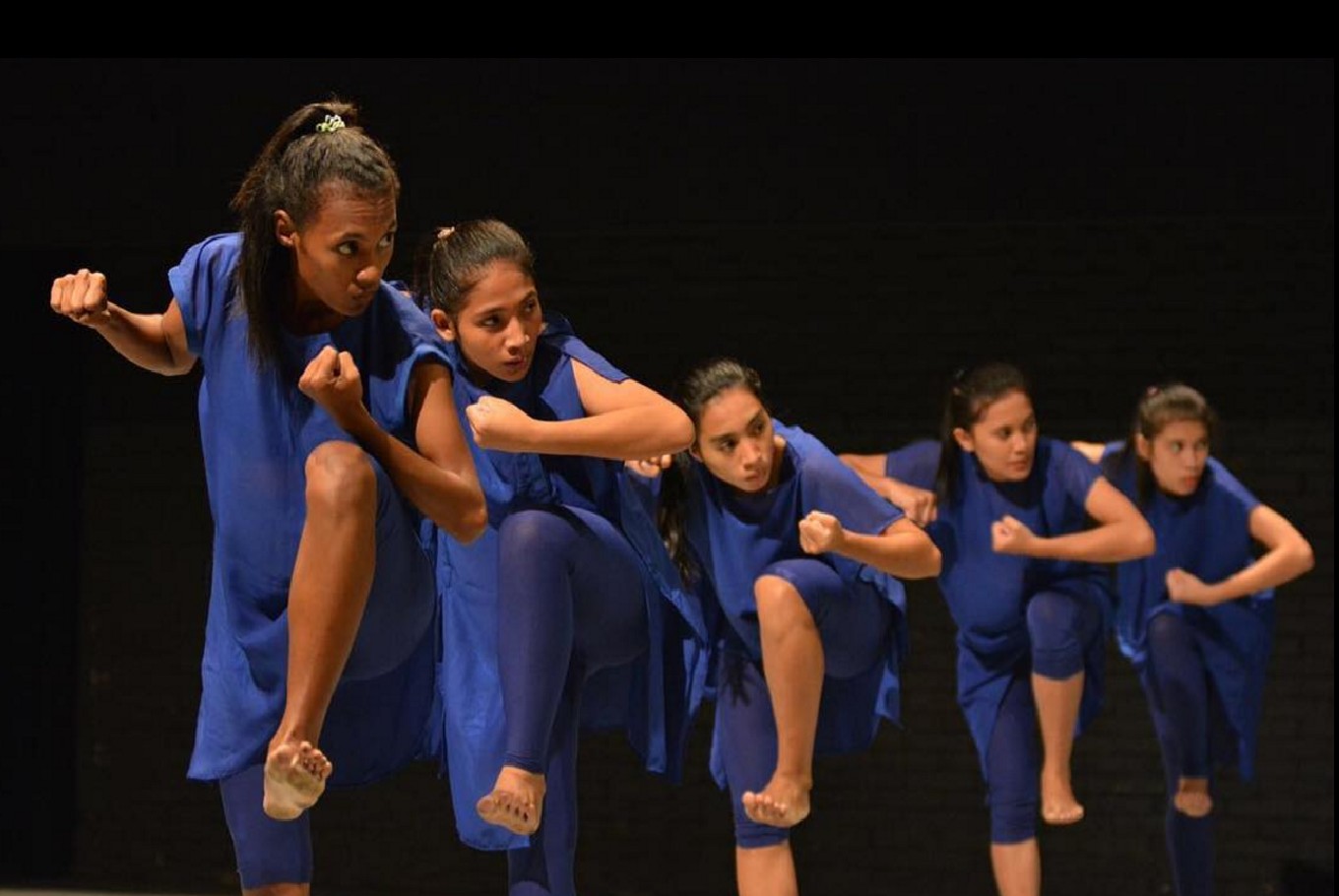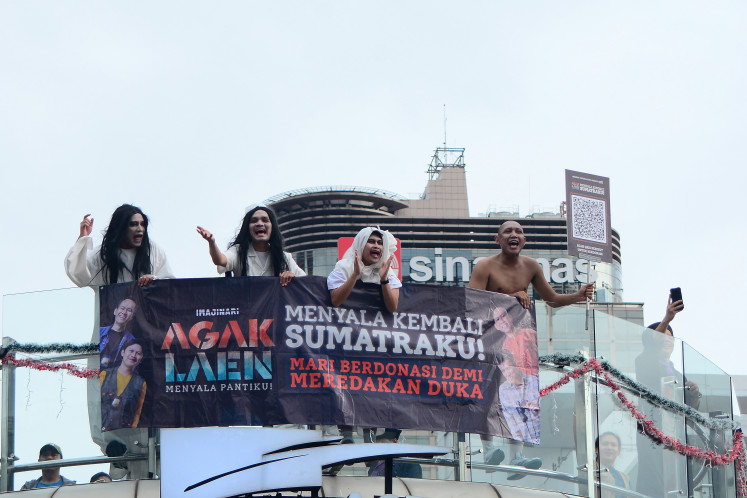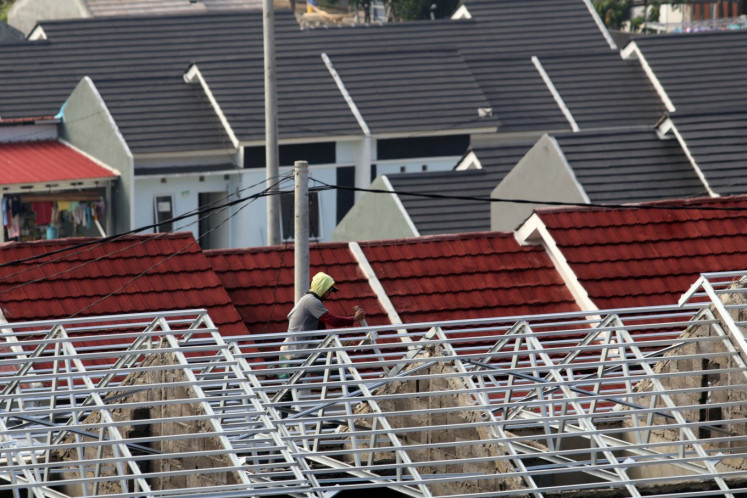Popular Reads
Top Results
Can't find what you're looking for?
View all search resultsPopular Reads
Top Results
Can't find what you're looking for?
View all search resultsCelebrating resilience of Jailolo women
Change text size
Gift Premium Articles
to Anyone
A modern interpretation of the traditional North Maluku war dance seeks to foster a love of local choreography.
Five female dancers with cheerful facial expressions and in blue tops illuminated by blue lights jumped around the stage in a circular formation, maximizing the use of the space by gravitating toward and moving away from each other. Their performance was accompanied by melodious vocalizations composed and performed by Nyak Ina “Ubiet” Raseuki. No props were seen onstage. It was the middle part of a 60-minute dance called Balabala directed by internationally acclaimed Indonesian choreographer Eko Supriyanto. The piece was performed by the EkosDance Company, featuring five young female dancers from the Jailolo district in West Halmahera, North Maluku. The dancers were Yimna Meylia Meylan Runggamusi, Siti Sadia Akil Djalil, Yezyuruni Forinti, Mega Istiqama Arma Dano Saleh and Dian Novita Lifu.
The performance, supported by the Embassy of Denmark, was staged on the last day of the Salihara International Performing Arts Festival 2016, which ran from Oct. 1 to Nov. 6.
When the music stopped, the set turned dark and the music changed into dissonant string arrangements. The previous cheerful expressions on the women turned very stern as they started to assume a line formation and move energetically.
“[The scene transition] depicts the unpredictable climate of Jailolo, where sudden downpours of rain happen all the time and so do electricity blackouts. The area is also highly vulnerable to earthquakes. It’s a tough environment,” Eko told The Jakarta Post after the performance.
(Read also: Eko Supriyanto's 'Cry Jailolo' dazzles in Paris festival)
The choreography was a modern interpretation of North Maluku war dances from the time of Portuguese colonization in the 16th century, namely Soya Soya and Cakalele. Traditionally, both dances were performed only by men, but this time around Eko enlisted an all-female troupe.
“As I immersed myself in the lives of the Jailolo women, interviewing and observing them, I came to realize how resilient they were. They are as tough as the men. They’re also always optimistic about the future,” said Eko, who danced for pop icon Madonna during her 2001 Drowned World Tour.
Eko explained that the Jailolo women dedicated themselves to what was known as the nine domains of life, comprising the sectors of family, community, the environment and religion, among others.
Despite the tough environment and the hardships that can befall one in life, sometimes including domestic violence and adultery, these women have remained stoic as they never seem to complain about their fate.
“Although they are very gentle, once they get angry or displeased, this can really show through their facial expressions and words, which can be just as hard as their environment,” Eko said, adding that these complex characteristics were shown in the dramaturgy transition. This is not the first time the choreographer was inspired by the Jailolo society: In 2014, he choreographed a dance called Cry Jailolo addressing the destruction of coral reefs that happened there and in May this year he worked with 250 junior and senior high school students in the area to produce a dance called Sasadu on the Sea as part of the 2016 Jailolo Bay Festival.
Eko said he deconstructed the war dances and adaptedthem to the women’s modern cultural context. Both dances are very dynamic and energetic in their nature, but he has incorporated a number of slow movement sequences, inspired by these women’s daily lives.
(Read also: Different cultural insights in Bali's Tenganan village)
“Now that they’re not at war anymore, life in Jailolo can be very relaxed. People there live in a very modest way. When it’s raining, they don’t use umbrellas or raincoats, they just enjoy the downpour. They remain calm when electricity is out. Whatever is available in their gardens, they enjoy as dishes.”
“This is why, once the dancers are able to memorize the movement sequences as they are traditionally performed, I ask them to enjoy some of the repertoire sequences the way they enjoy the rain,” Eko said.
This explains why during the performance, the audience saw several slow-fast-slow movement sequences.
The selection of the dancers also had a cultural mission: By picking five young amateur female dancers, Eko said he sought to transfer the love of local North Maluku dances to the next generation. He scouted the talents while preparing the Sasadu on the Sea performance.
The zenith of the performance came a few minutes before it ended when the bombastic music stopped and the five women started to talk rapidly yet melodiously in their local language in disparate speeches, telling stories of how their days went.
Soon all the women talked simultaneously, creating a cacophony. This is when they brought an indigenous cultural touch to the choreography.
“I’m fascinated by the musical aspect of these women’s speech: It contains infinite and unexpected possibilities of high- and low-pitched tones. They like to talk and do it rapidly,” Eko says. “I want to capture the musicality of their language with that scene.”











